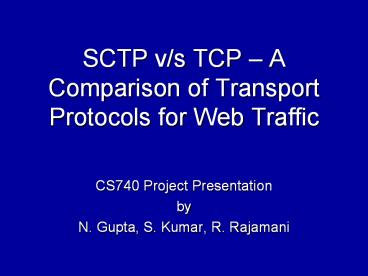SCTP%20v/s%20TCP%20 - PowerPoint PPT Presentation
Title:
SCTP%20v/s%20TCP%20
Description:
Many applications need reliable message delivery they do so by delineating a TCP stream ... Jim Gast, Joel Sommers, Winfred Byrd, CSL ... – PowerPoint PPT presentation
Number of Views:222
Avg rating:3.0/5.0
Title: SCTP%20v/s%20TCP%20
1
SCTP v/s TCP A Comparison of Transport
Protocols for Web Traffic
- CS740 Project Presentation
- by
- N. Gupta, S. Kumar, R. Rajamani
2
Outline
- Motivation
- Introduction to SCTP
- Server Architecture
- Experimental Design
- Parameters
- Results
- Conclusion
3
Motivation
- Many applications need reliable message delivery
they do so by delineating a TCP stream - TCP provides both strict-ordering and reliability
many applications may not need both
4
Motivation (contd)
- HTTP is one such application
- While transferring multiple embedded files we
only want - Reliable file transfer for each file
- Partial ordering for the packets of each file but
not total ordering amongst all the packets - TCP provides more than this (but overhead?)
- SCTP may help (how? later)
5
What is SCTP?
- Originally designed to support PSTN signaling
messages over IP Networks - It is a reliable transport protocol operating on
top of a connectionless packet network such as IP
(same level as TCP)
6
Major Differences from TCP
- SCTP is message oriented as opposed to being byte
stream oriented - SCTP has the concept of an association instead of
a connection - Each association can have multiple streams
- SCTP separates reliable transfer of datagrams
from the delivery mechanism - SCTP supports multihoming
- Connection Setup
7
Packet Format
8
Similarities to TCP
- Similar Flow Control and Congestion Control
Strategies employed - Slow Start and Congestion Avoidance phases
- Selective Acknowledgement
- Fast Retransmit
- Slight differences for supporting multihoming
- Will allow co-existence of TCP and SCTP JST 2000
9
HTTP Server Architecture
Single File Transfer ( Both TCP and SCTP are
similar)
Child process
10
HTTP Server Architecture
Multiple File Transfer (Embedded files) - TCP
Child process
11
SCTP Packet Format
streams
12
HTTP Server Architecture
Multiple Files Transfer (Embedded Files) - SCTP
Child process
13
The Scientific Method
- Observation HTTP does not require strict-order
of delivery, when fetching embedded links. Also,
HTTP is message-oriented protocol - Hypothesis and Predictions SCTP provides
partially ordered delivery and guarantees
reliability. This can reduce user-perceived
latency and improve throughput
14
Hypothesis
Server
Client
1
3
2
1
3
2
1
3
2
1
File 1
File 2
File 3
TCP Receive buffer in kernel
15
Hypothesis
Server
Client
1
3
2
1
3
2
1
3
2
1
File 1
File 2
File 3
SCTP Receive buffer in kernel
16
Experimental Design
- FreeBSD kernel implementation of SCTP and TCP
Reno - HTTP 1.1 Server and Client
- Similar implementations for TCP/SCTP
- Dummynet to simulate interconnection network
17
Our setup
Server
Client
Dummynet configured with different b/w, delay and
loss characteristics
18
Parameters
- We observe latencies for single file and multiple
file transfers by varying the following
parameters - Loss rate (0, 1, 2, 5, 8, 10, 15, 20,
25) - Link Bandwidth (40kbps, 400kbps, 3mbps,10mbps)
- We keep Latency constant (80ms)
19
Results
20
Results
21
Results
22
About Errors
Loss in this direction 1
Loss in this direction 1
23
Reason
Server
Client
3
2
1
3
2
3
2
1
3
2
1
1
File 2
File 3
TCP Receive buffer in kernel
TCP Send buffer in kernel
24
Reason
Server
Client
3
3
2
2
3
2
1
3
2
1
1
1
File 2
File 3
SCTP Receive buffer in kernel
SCTP Receive buffer in kernel
25
Conclusions
- The current SCTP implementation performs almost
as well as TCP when there are no losses
However, there is an extra overhead in sending
messages instead of just a stream of bytes - SCTP seems to perform better in the presence of
losses, because it does not enforce strictly
ordered delivery - More graphs available at http//www.cs.wisc.edu/r
aj/sctp
26
Implications
- SCTP can be a viable transport protocol for HTTP
traffic, because - It helps reduce user-perceived latency and also
improves throughput - Uses a 4-way handshake and also uses an encrypted
cookie, which offer better protection against SYN
floods and DoS attacks - Multihoming feature can be exploited to
transparently allow mobile users to switch
between networks
27
References
- CT90 D. Clark and D. Tennenhouse, Architectural
Consideration for a New Generation of Protocols,
In Proc. of ACM SIGCOMM '90. - RFC 2960 (http//www.rfc-editor.org)
- http//tdrwww.exp-math.uni-essen.de/pages/forschun
g/sctp_fb/ - JST 2000 A. Jungmaier, et. al, Performance
Evaluation of the Stream Control Transmission
Protocol, In Proc. of the IEEE conference on High
Performance Switching and Routing, June 2000.
28
Acknowledgements
- Paul Barford
- Doug Thain
- Jim Gast, Joel Sommers, Winfred Byrd, CSL
- Randall Stewart, Jon Grimm, La Monte Henry Piggy
Yarroll
29
Questions?
30
Server Architecture
- Single File Transfer
- Server forks a child process for each request
- Child parses the request and sends the requested
file or an appropriate error message - Similar for both TCP and SCTP
31
Server Architecture contd.
- Multiple File Transfer (embedded files)
- TCP
- Child process at server parses the request and
sends the requested file - Client parses the received file and sends the
requests for embedded files - Child process at server receives these requests
and sends the files one after other using
persistent connection
32
Server Architecture contd.
- Multiple files transfer (embedded files)
- SCTP
- Child process at server parses the request and
sends the requested file - Client parses the received file and sends
requests for embedded files - Child process at server receives the requests and
sends the files on different streams within the
same association - Major difference from TCP
33
Server Architecture
Single File Transfer ( Both TCP and SCTP are
similar)
Client
Server
request
Fork child
Child process
response






























